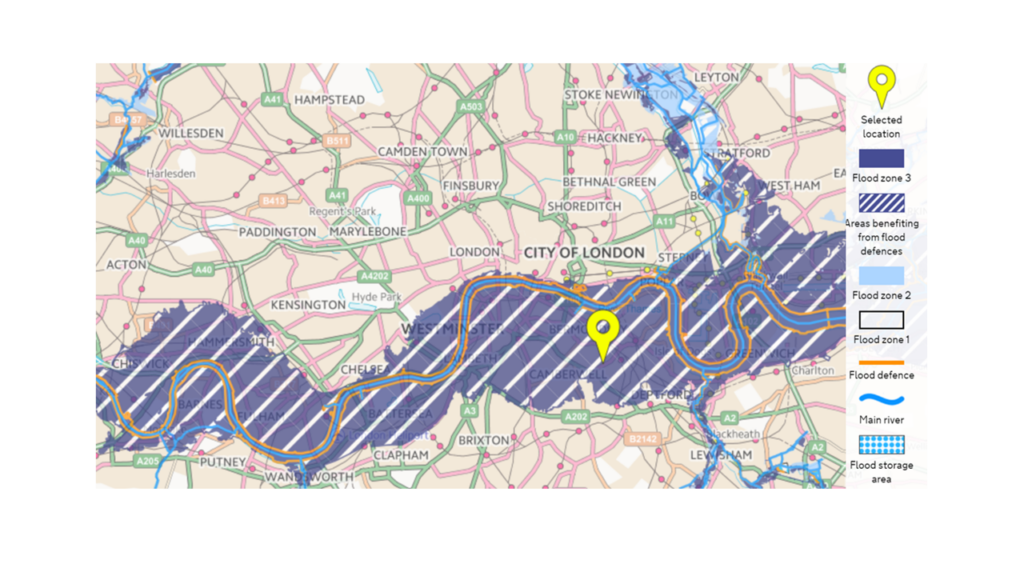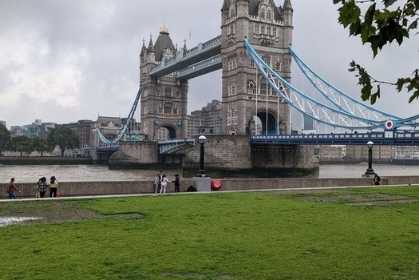Flood Risk Assessments for London
With the vast popularity of London life, desire to build within a London borough has increased over the past decade. However, much of London is within a Critical Drainage Area and therefore legislation can be more complex than other areas of the UK.
Our Flood Risk Team have years of experience dealing with London based Flood Authorities and the intricacies of London flood policy, giving us a unique insight to help you gain planning permission in London - from rear extensions to major applications, we've worked on them all!
Flood Risk Assessments For London
Without a Flood Risk Assessment, your London planning application could be rejected. Each of our Flood Risk Assessments are tailored to your development, meeting all local planning requirements, to help you better understand and mitigate the risk of flooding to your site.
Why not get in touch with the team today for a free quotation or fill in our quote request form below.
Aegaea holds all the relevant flood models and breach data for London on our own systems, so there’s no delay in your application while waiting for data.
Unlocking Development In London
The City of London has been constructed on a large floodplain. As such, the vast majority of it is within a Flood Zone.
Central London, in particular, is affected by multiple sources of flooding.
Thankfully, the Thames Barrier protects it to a 1 in 1000-year standard up to the year 2100.
Without it, London would be at a much greater risk of flooding.
Isn’t The Flood Map For Planning Enough?
No! The Environment Agency flood map for planning only shows the flood risk from rivers and seas without the presence of defences.
London policy has requirements on breach analysis, surface water, residual risk and critical drainage areas!
The data sets that inform on this risk are not immediately accessible through the Environment Agency (though they can be requests).
When assessing flood risk throughout London, our team will review large amounts of data to give you a clear picture of risk.
Read more about why Flood Risk Assessments in London differ from other parts of the UK.
Surface Water
Due to its urban characteristics, London is greatly affected by surface water and sewer flooding.
London also contains many boroughs that are considered Critical Drainage Areas.
These are areas where surface water is unable to drain at an appropriate rate, causing further flooding. These areas always require a Flood Risk Assessment, no matter the development.
Residual Risk (Breach)
What happens if defences fail?
Though this is considered to be a highly unlikely scenario, much of London is still assessed based on the question, “What would happen if?”
However small the possibility, the results of such an event would be devastating to much of the area.
What Sets Aegaea Apart?
Across London, the severity and extent of each source of flooding vary.
It is, therefore, important for the success of a project to understand what flood zone your site is located in and whether it is affected by other sources of flooding.
This could impact the design, timeframes, and mitigation measures required to make the development acceptable for planning.
If each flood risk source has not been appropriately reviewed, the Environment Agency or Local Planning Authority will likely reject it at Planning.
We’ve got in-depth knowledge of London Borough Policy and how it impacts your plans.
Need A Flood Risk Assessment In London? Our Team's Ready To Support You.
Leading London Flood Risk Experts from Aegaea
London Flood Risk Assessment FAQs
A Flood Risk Assessment (also known as an FRA) is a planning document that allows clients and local authorities to assess the flood risk to a site. This allows local authorities to understand whether a development will be safe to build in its current state in relation to different types of flooding.
FRA’s are necessary for many different project sizes, from new home extensions to constructing multiple properties on a large piece of land. It assesses multiple sources of flooding to your existing and future development/site, whilst referencing National and Local Planning Policies.
The flood assessment further establishes whether any other third parties could provide comments about the development (such as; Environment Agency, Local Drainage Boards, Lead Local Flood Authority, etc).
The key outcomes of the flooding risk assessment in a basic form are;
- Establish the risk of flooding to the site
- Cross-reference the findings from a review of the flood data against national and local planning policy
- Confirm what is and is not viable based on the initial data review
- Review proposed design/layout and comment on whether the development would be acceptable for planning
- Assess impacts onsite and offsite as a result of constructing the development
- Advise and provide recommendations of what mitigation measures could be introduced to prevent flooding impacting the site, its future users/occupants, and whether it increases the risk of flooding elsewhere, post-construction.
It should be noted that even if a development can be shown to be mitigated from the flood risk, planning authorities still may not deem it acceptable for construction. Certain developments have stricter planning and are therefore more stringent on what is and isn’t acceptable. This is something we can advise you on upfront during our initial consultation so you’ll know if there are some additional complexities with your project or the flood zone it’s located in.
Read more about what a flood risk assessment is.
In England, a FRA is required when the development or site is located in Flood Zone 2 and 3 according to the Environment Agency flood map for planning. An FRA is also required if the Site is in Flood Zone 1 when it is equal to or greater than 1 hectare in size or if it’s located within a Critical Drainage Area regardless of its size.
Even with this in mind, the National Planning Policy Framework requires an FRA to be used to assess all sources of flooding. Therefore an FRA could be requested even if your site doesn’t fit these requirements. Especially if there is a history of flooding, such as from a sewer or reservoir.
If your site is within 20 meters of an Environment Agency (EA) Main River, it’s also highly likely you’ll be required to provide an FRA with a particular focus on the EA Guidance.
It’s important to understand if you need a flood risk assessment for your development early on in your idea phase. For starters, you’ll want to know if your development is actually at risk of flooding. If your site is within a flood zone, any application submitted without an FRA will likely be rejected.
When this happens, you may have to make some costly changes to your plans, not to mention delays. These changes could range from increasing the floor height to moving buildings elsewhere on the site. It’ll be much easier and cost effective if you know going into the design phase where you need to mitigate your risks.
Thankfully, the Environment Agency provide a free postcode checker to establish whether you’re in a flood zone and therefore would likely require a Flood Risk Assessment to gain planning permission. We’ve included an example map of London below.
You can access the EA Flood Map for Planning here

By using the EA Flood Map, you can see if your site is located in a lightly shaded blue area (Flood Zone 2) or a dark shaded blue area (Flood Zone 3). Both of these mean your site is at risk of flooding and any future development would then require a Flood Risk Assessment. This isn’t entirely inclusive, as there are many sites not within Flood Zone 2 or 3 that will also require an FRA, but it’s a good starting point.
If you want confirmation, you should seek advice from an expert.
If your site is located within a flood zone, that doesn’t mean it’s the end of your development plans. Our team has supported many complex projects, including large developments in Flood Zone 3b (the greatest flood zone risk in the English Planning System). In fact, we really enjoy making these projects work. If you have any questions about the viability of your project, or understanding what flood zone your project is within, don’t hesitate to contact our team.
There are 3 main flood zones used in England under the National Planning Policy Framework and Environment Agency categorisation. Flood Zone 1, 2, and 3, with 1 being the lowest risk and 3 being the highest. There is, however, a fourth category for functional floodplains, known as Flood Zone 3b. This is not shown on the EA flood map for planning but we’ve discussed it more below.
Flood zones are derived by hydraulic computational models produced by the EA or private ownership. England has a detailed network of rivers and it is of national importance to establish which rivers and areas in the country could be more susceptible to flooding from a fluvial or tidal source (rivers and sea).
The three main flood zones are categorised on the EA flood map as;
- Flood Zone 1 – Low risk of flooding from rivers or seas – no blue shading
- Flood Zone 2 – Medium risk of flooding from rivers or seas – light blue colour
- Flood Zone 3 – High risk of flooding from rivers or seas – dark blue colour
However, Flood Zone 3 is unique in that it contains two zones;
- Flood Zone 3a, and;
- Flood Zone 3b – Functional Floodplain
The reason these have been further split is because they could be the difference between a development being accepted at planning, or not being rejected.
To provide greater context of the two flood zones we’ve included a table extracted from the National Planning Practice Guidance – Flood Risk Vulnerability and Flood Zone Compatibility. The table sets out the flood zones on the left column and the vulnerability of uses on the top row. To provide more context of what the vulnerability classifications include, we’ve included two examples;
More Vulnerable
- Hospitals
- Residential institutions such as residential care homes, children’s homes, social services homes, prisons, and hostels.
- Buildings used for dwelling houses, student halls of residence, drinking establishments, nightclubs, and hotels.
- Sites used for holiday or short-let caravans and camping, subject to a specific warning and evacuation plan.
Less Vulnerable
- Police, ambulance, and fire stations which are not required to be operational during flooding.
- Buildings used for shops; financial, professional and other services; restaurants, cafes and hot food takeaways; offices; general industry, storage, and distribution; non-residential institutions not included in the ‘more vulnerable’ class; and assembly, and leisure.
- Land and buildings used for agriculture and forestry.
The aim of the sequential test is to steer new development to areas with the lowest risk of flooding. Development should not be allocated or permitted if there are reasonably available sites appropriate for the proposed development in areas with a lower risk of flooding. The strategic flood risk assessment will provide the basis for applying this test. The sequential approach should be used in areas known to be at risk now or in the future from any form of flooding.
The National Planning Policy Framework (NPPF) details that all plans and strategic policies informed by a Strategic Flood Risk Assessment should apply a sequential, risk-based approach to the location of the development. Inappropriate development in areas at risk of flooding should be avoided by directing development away from areas at high risk. This isn’t necessarily always possible and when this occurs the development should be made safe for its lifetime, specific to its use and without increasing flood risk elsewhere.
The sequential risk-based approach to the location of development should also consider the current and future impacts of climate change. In circumstances where it is demonstrated that the site could be at risk of flooding or is currently in a flood zone, then it is necessary to apply the Exception Test which is discussed below in greater detail.
In summary, the sequential test is required to be applied for strategic planning purposes reviewing site allocations and the flood zones they are located within to support the Local Plan. The Sequential Test can also be applied for single planning applications. In both instances, it is encouraged that new development should be located in areas of lowest flood risk – Flood Zone 1.
If your site is located in Flood Zone 2 or 3 then it could be requested by the Local Planning Authority and Lead Local Flood Authority to produce a Sequential Test, which justifies why development of your site in a flood zone over another which is not, is preferred and should be considered.
It should be further noted that where planning applications come forward on sites allocated in the development plan through the sequential test, applicants need not apply the sequential test. This is because it has already been conducted by the Lead Local Flood Authority / Local Planning Authority.
To discover whether your development could require a sequential test as well as a Flood Risk Assessment contact us and we can work with you to talk through your site, aspirations of development and how best to mitigate flood risk.
The Exception Test is necessary when a development is located in a flood zone.
The need for the exception test will depend on the potential vulnerability of the site and of the development proposed.This is in line with the Flood Risk Vulnerability Classification set out in National Planning Policy Guidance.
The Exception Test consists of two parts. Both elements should be satisfied for the development to be allocated (Development Plan) or permitted (planning application).
For the exception test to be passed it should be demonstrated that:
The development would provide wider sustainability benefits to the community that outweigh the flood risk;
The development will be safe for its lifetime taking account of the vulnerability of its users, without increasing flood risk elsewhere, and, where possible, will reduce flood risk overall.
A professionally written, researched and thought-out Flood Risk Assessment can add real value to your planning application. It can reduce costs of the application process through redesign, time, and water management.
Our highly experienced team can review developments against the policy requirements and flood zones. We then use our industry experience and knowledge of local regions to make sure that we get you the right answer. We do this all for a highly competitive price, with no “one size fits all” quotes.
There are a lot of different parameters that can influence the time it takes to complete an FRA. Each project is unique and has different flood risks, designs, environmental conditions, topography, historic uses, and are subject to different planning policies. All of these can affect the time it takes for a flood risk assessment to be completed. The industry standard for an FRA is around 4 to 6 weeks.
Our team, however, have experience in supporting over 1,000 projects and have developed methods and techniques to analyse data efficiently and effectively review every aspect in a timely manner. On average, our FRA reports take 5 to 10 working days once we have received the necessary data.
If a site is located in Flood Zone 2 or 3, generally we would request data from the Environmental Agency (EA), or the relevant governing agency / third party. The Environment Agency have a statutory 20 working day (4 weeks) turnaround for all enquiries, including data. This turnaround time is echoed by most third party providers.
From then, we will conduct a thorough analysis with industry leading software and our in house tools. Once this is done, we’ll review the results with you and examine the risk of flooding before we complete the report. We make sure to keep you up-to-date throughout the whole process so you’re always aware of timelines. That way, you can get on with organising the rest of the planning application.
The key outcomes of the assessment in a basic form are;
-
Establish the risk of flooding to the Site from multiple sources – Watercourse, Coastal, Rainfall, Groundwater and Sewer as well as residual risks these can include canal and reservoir flooding and even breach/ failure of defences where required.
-
Cross-reference of the findings from a review of the flood data against planning policy
-
Advise, consultant and confirm what is and is not viable based on the initial data review
-
Review proposed design/layout and comment on whether the development would be acceptable for planning
-
Assess impacts onsite and offsite as a result of constructing the development
-
Advise and provide recommendations of what mitigation measures could be introduced to prevent flooding impacting the Site, its future users/occupants, and whether it increases the risk of flooding elsewhere, post-construction.
Also, it should be noted that just because a development can be prevented from flooding, it does not make it acceptable to be constructed. There are certain developments where the stringency of planning is less, and more is accepted in terms of what is an acceptable level of flooding or risk to future users.
Happy Customers
Does London Development Have To Adhere To National Planning Policy?
In addition to all the multiple sources of flooding that are required to be reviewed to support a Flood Risk Assessment for Planning, there is also a need to adhere to multiple policies.
Development in London is subject to:
-
National Planning Policy
-
Regional Planning Policy
-
The London Plan
-
Local London Borough Planning Policies
As there is such a complex web of different policies that must be adhered to, it’s important to engage with a specialist who can advise you on the best practices for your development early on. Policy changes from borough to borough, so it’s not a case of just understanding the policy as a whole.
How Our London Flood Risk Assessment Team Can Support You
Every site and project is unique.
Some may consist of only one flood zone, whereas others could consist of multiple flood zones and multiple sources of flooding (fluvial/tidal/pluvial/groundwater/sewer/residual).
Our team has supported over 1,000 projects of varying complexities and scales of development, giving us a unique insight into the planning process.
Through our experience, our team can work from the pre-planning stages to submitting your application, advising on the design, layout, and mitigation measures to ensure your project gains planning permission on the first application.
If you are proposing a development in a London Borough and are unsure if you require a flood risk assessment or which flood zone you are located in, contact our team using the contact form here, or request a quote for your project using the form below.
Request your free, expert quote now
Aegaea work alongside home owners, private developers, planning consultants, architects, local authorities, international development agencies and contractors. Aegaea know exactly how to help you.



